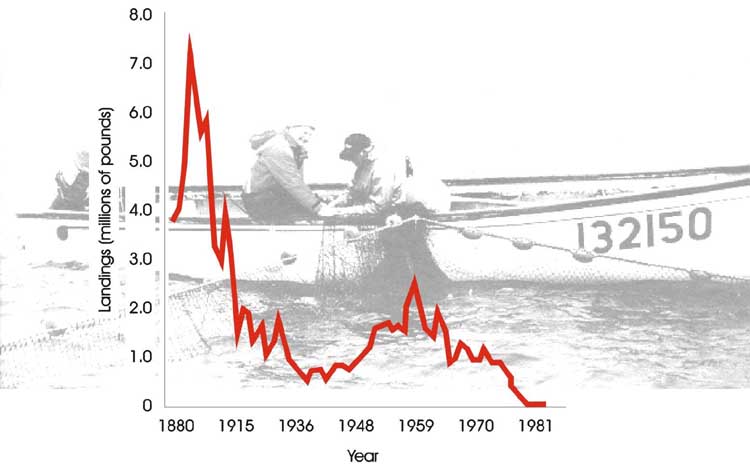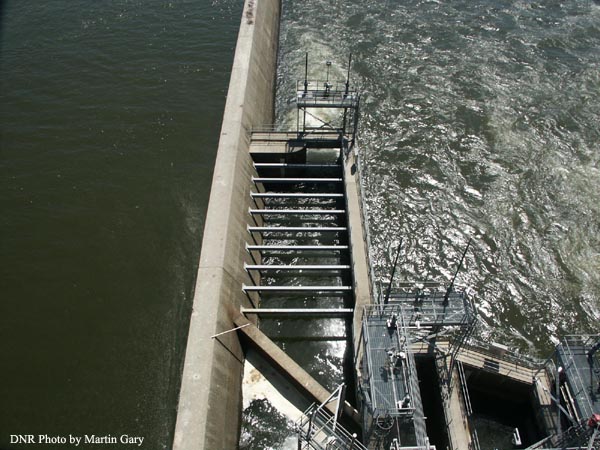"...to provide for fish passage at dams, and remove stream blockages wherever necessary to restore passage for migratory fish..."
That was the primary goal of the Fish Passage Program (FPP) when it was Established in the Chesapeake Bay Agreement in 1987. This landmark agreement Included commitments by Maryland, Pennsylvania, Virginia, and the District of Columbia. Our initial efforts were focused on reopening over 1,300 miles for Anadromous species like shad and herring, so they could reach upstream spawning Habitat. After surpassing our original goal by opening 1,838 miles by 2005, the group decided to expand the goal to 3,500 miles by 2025. This new goal now includes opening habitat for all fish species and favors dam removals over fish ladders. Click here for  details on the goal.
details on the goal.
Fish Passage History & Background

To many anglers the mere mention of the American shad can send chills down one's spine and conjure up memories of a crisp spring morning on the Susquehanna River spent battling one of these magnificent fish. The American shad is just one of several anadromous fish in Maryland which are born in the freshwater streams, migrate to the ocean where they live for several years, then return to freshwater rivers to spawn. Other anadromous fish visiting the bay include hickory shad, alewife herring, and blueback herring. Alewife and blueback herring are commonly grouped together and referred to as river herring. Juvenile shad and herring spend most of their time in large schools out in the Atlantic Ocean feeding on fish, shrimp, squid, fish eggs, small crabs, plankton, and other small organisms. After approximately 3 to 4 years when the fish reach sexual maturity, they begin to migrate back to the rivers where they were born. Shad and herring arrive in the Chesapeake Bay typically in March and April, although they can be seen as early as February and as late as June, depending on temperature. American Shad usually arrive in the Chesapeake Bay in May. Once spawning is complete, the fish return to the ocean where they become valuable forage for species including Striped Bass.
Shad and Herring have long been a major resource. To the American Indians, the American shad was a common staple food, and early European settlers also depended on the annual shad runs for survival. It was common for every family to have a barrel of salted shad at their home, George Washington even had a shad fishery at his house. Commercial harvest for American shad began around 1800. At the peak of harvest in 1890, commercial landings of American shad in Maryland exceeded 7 million pounds. Commercial exploitation of American shad in Maryland and along the entire Atlantic seaboard continued through the 1960's. In 1979 commercial landings of American shad in Maryland had declined to only 18,000 pounds. Herring and hickory shad suffered similar declines and by the 1970's all 4 species were near collapse. In 1980 the commercial and recreational fisheries for American shad in Maryland were closed. A similar closing for hickory shad occurred in 1981. River herring suffered heavy exploitation from foreign fishing fleets until 1973 when agreements between the U.S. and foreign countries limited commercial landings.
Commercial exploitation was not the only factor contributing to the decline of these anadromous fish. During the late 1800's and early 1900's the population and infrastructure within the United States grew rapidly. Across Maryland and the entire east coast, vast expanses of forests were being harvested to provide materials for buildings, ships, and other goods. Many mill dams were constructed, as were dams which provided flood control and hydropower for factories and homes. The dams prevented shad and herring from migrating up the rivers to their spawning grounds, thereby limiting the habitat available to them. The clearing of forests caused large amounts of sediment to be flushed into the streams and rivers, smothering the eggs of shad, herring and other fish. Throughout the 1900's, the increasing construction of roads caused the need for culverts to be placed where roads crossed streams. The culverts created additional barriers to the anadromous fish attempting to migrate upstream to historically available spawning habitat.
In 1987, the Chesapeake Bay Agreement was signed by states within the Chesapeake Bay region including Maryland, Pennsylvania, Virginia and the District of Columbia. This agreement included commitments for providing fish passage within each state: "to provide for fish passage at dams, and remove stream blockages wherever necessary to restore passage for migratory fish." With this humble beginning, the Chesapeake Bay states set a goal to reopen a total of 1,357 miles of historical spawning grounds by the year 2003. Maryland's portion of this goal is to reopen 388.65 miles of stream. The Maryland Department of Natural Resources Fish Passage Program has taken this commitment very seriously; to date the Program has completed 61 projects, reopening a total 348.9 miles of upstream spawning habitat. Several projects scheduled to be completed by 2003 will allow the Program to not only meet but also exceed the goal set forth by the Chesapeake Bay Agreement. Meeting this goal has been a cooperative effort between the Maryland Department of Natural Resources, State Highway Administration, National Marine Fisheries Service - National Oceanic & Atmospheric Administration, Department of Interior - US Fish & Wildlife, Environmental Protection Agency, Chesapeake Bay Program, Chesapeake Bay Foundation, University Maryland and a multitude of others including private citizens, local watershed groups and local governments.
 Once a blockage has been identified, the target species are found to be present in the downstream area of the blockage and the upstream habitat is suitable for spawning, providing fish passage can be accomplished in a variety of ways depending upon the situation. The removal of the blockage is usually considered to be the best solution for fish passage and stream restoration as it allows for the waterway to return to a natural state and no structures are left to maintain. If removal or a breach is not an option, engineers and biologists will decide whether to build a fish passage device. Fish passage types include an Alaskan Steeppass-type fishway, a Denil-type fishway, pool and weir structure, natural remedies to control flow, a fish lift, a notch, or a combination of these options. The hydrological design behind a Denil or Steeppass fishway is very complex, but the basic idea is to provide a continuous stream of low velocity water to the fish so that they can ascend up the fishway and exit above the dam or blockage to access the upstream habitat. Both the Denil and Steeppass fishway structures are similar to a chute with baffles inside which act to slow down the water running through the fishway allowing the fish to follow their instinct to swim upstream against the current without tiring. In order to function properly, fishways must be maintained and kept clear of debris including sticks and leaves which can act as a blockage unless removed. The Fish Passage Program relies heavily on it's volunteers to help keep the fishways clear and free of debris during the critical spring spawning season. A big "thanks" to the many volunteers who have helped the Program over the years.
Once a blockage has been identified, the target species are found to be present in the downstream area of the blockage and the upstream habitat is suitable for spawning, providing fish passage can be accomplished in a variety of ways depending upon the situation. The removal of the blockage is usually considered to be the best solution for fish passage and stream restoration as it allows for the waterway to return to a natural state and no structures are left to maintain. If removal or a breach is not an option, engineers and biologists will decide whether to build a fish passage device. Fish passage types include an Alaskan Steeppass-type fishway, a Denil-type fishway, pool and weir structure, natural remedies to control flow, a fish lift, a notch, or a combination of these options. The hydrological design behind a Denil or Steeppass fishway is very complex, but the basic idea is to provide a continuous stream of low velocity water to the fish so that they can ascend up the fishway and exit above the dam or blockage to access the upstream habitat. Both the Denil and Steeppass fishway structures are similar to a chute with baffles inside which act to slow down the water running through the fishway allowing the fish to follow their instinct to swim upstream against the current without tiring. In order to function properly, fishways must be maintained and kept clear of debris including sticks and leaves which can act as a blockage unless removed. The Fish Passage Program relies heavily on it's volunteers to help keep the fishways clear and free of debris during the critical spring spawning season. A big "thanks" to the many volunteers who have helped the Program over the years.
 Once fish passage has been provided at a site, biologists monitor the structure to ensure it is operating properly and that fish are able to ascend above the former blockage. Through biological monitoring, biologists have documented that at least 33 species of fish have ascended a fish passage structure in Maryland, including Maryland's primary target species which are the American shad, hickory shad, alewife and blueback herring.
Once fish passage has been provided at a site, biologists monitor the structure to ensure it is operating properly and that fish are able to ascend above the former blockage. Through biological monitoring, biologists have documented that at least 33 species of fish have ascended a fish passage structure in Maryland, including Maryland's primary target species which are the American shad, hickory shad, alewife and blueback herring.
For more information about Maryland's Fish Passage Program, to learn how to become a volunteer, or to report a fish blockage, please email:
Jim Thompson